Logistics & Supply Chain Management
VerifiedAdded on 2023/03/31
|11
|2514
|173
AI Summary
This report examines supply chain management at Singapore Pte. Ltd, focusing on supplier selection criteria, ICT for purchasing operations, and purchasing cost analysis. Recommendations are provided for improving the company's supply chain.
Contribute Materials
Your contribution can guide someone’s learning journey. Share your
documents today.
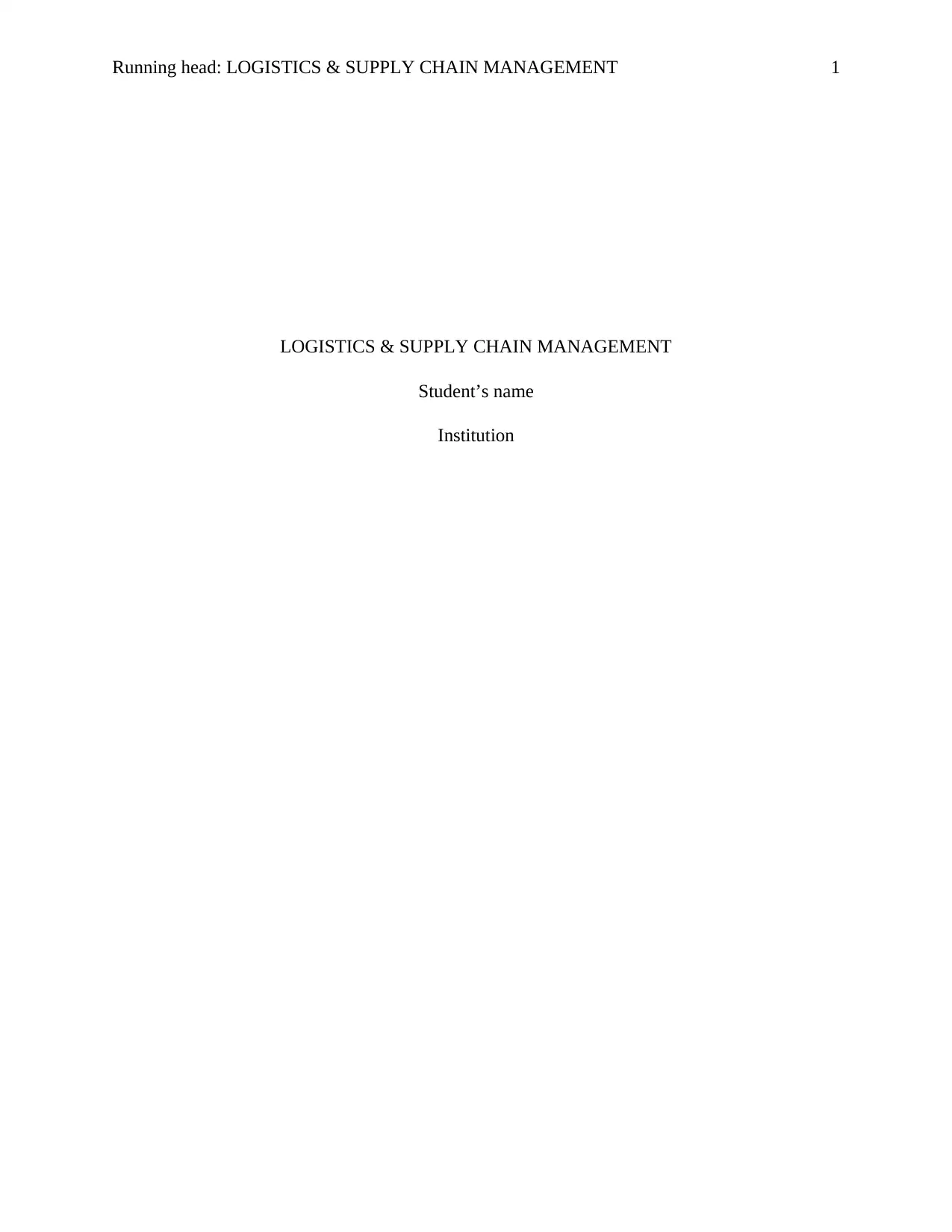
Running head: LOGISTICS & SUPPLY CHAIN MANAGEMENT 1
LOGISTICS & SUPPLY CHAIN MANAGEMENT
Student’s name
Institution
LOGISTICS & SUPPLY CHAIN MANAGEMENT
Student’s name
Institution
Secure Best Marks with AI Grader
Need help grading? Try our AI Grader for instant feedback on your assignments.
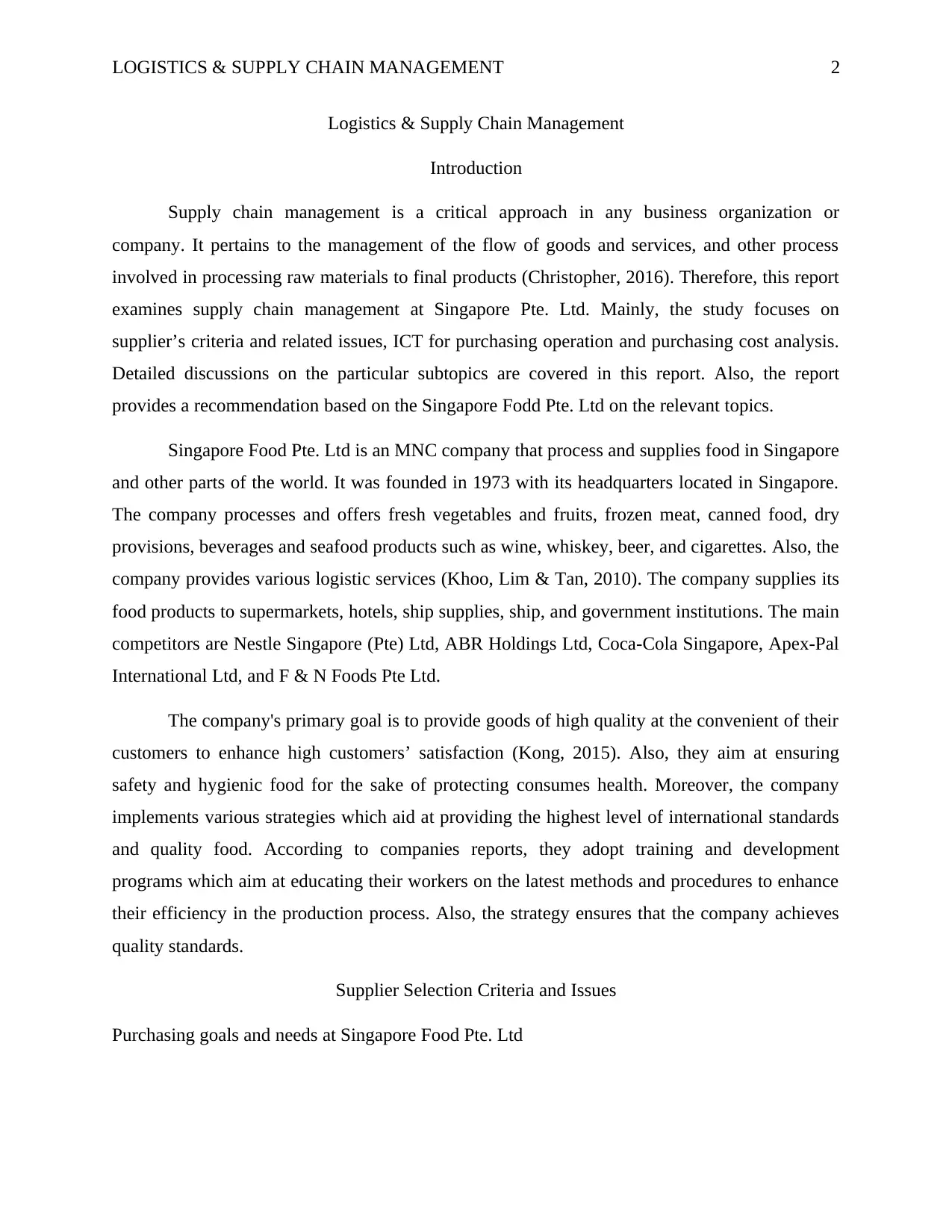
LOGISTICS & SUPPLY CHAIN MANAGEMENT 2
Logistics & Supply Chain Management
Introduction
Supply chain management is a critical approach in any business organization or
company. It pertains to the management of the flow of goods and services, and other process
involved in processing raw materials to final products (Christopher, 2016). Therefore, this report
examines supply chain management at Singapore Pte. Ltd. Mainly, the study focuses on
supplier’s criteria and related issues, ICT for purchasing operation and purchasing cost analysis.
Detailed discussions on the particular subtopics are covered in this report. Also, the report
provides a recommendation based on the Singapore Fodd Pte. Ltd on the relevant topics.
Singapore Food Pte. Ltd is an MNC company that process and supplies food in Singapore
and other parts of the world. It was founded in 1973 with its headquarters located in Singapore.
The company processes and offers fresh vegetables and fruits, frozen meat, canned food, dry
provisions, beverages and seafood products such as wine, whiskey, beer, and cigarettes. Also, the
company provides various logistic services (Khoo, Lim & Tan, 2010). The company supplies its
food products to supermarkets, hotels, ship supplies, ship, and government institutions. The main
competitors are Nestle Singapore (Pte) Ltd, ABR Holdings Ltd, Coca-Cola Singapore, Apex-Pal
International Ltd, and F & N Foods Pte Ltd.
The company's primary goal is to provide goods of high quality at the convenient of their
customers to enhance high customers’ satisfaction (Kong, 2015). Also, they aim at ensuring
safety and hygienic food for the sake of protecting consumes health. Moreover, the company
implements various strategies which aid at providing the highest level of international standards
and quality food. According to companies reports, they adopt training and development
programs which aim at educating their workers on the latest methods and procedures to enhance
their efficiency in the production process. Also, the strategy ensures that the company achieves
quality standards.
Supplier Selection Criteria and Issues
Purchasing goals and needs at Singapore Food Pte. Ltd
Logistics & Supply Chain Management
Introduction
Supply chain management is a critical approach in any business organization or
company. It pertains to the management of the flow of goods and services, and other process
involved in processing raw materials to final products (Christopher, 2016). Therefore, this report
examines supply chain management at Singapore Pte. Ltd. Mainly, the study focuses on
supplier’s criteria and related issues, ICT for purchasing operation and purchasing cost analysis.
Detailed discussions on the particular subtopics are covered in this report. Also, the report
provides a recommendation based on the Singapore Fodd Pte. Ltd on the relevant topics.
Singapore Food Pte. Ltd is an MNC company that process and supplies food in Singapore
and other parts of the world. It was founded in 1973 with its headquarters located in Singapore.
The company processes and offers fresh vegetables and fruits, frozen meat, canned food, dry
provisions, beverages and seafood products such as wine, whiskey, beer, and cigarettes. Also, the
company provides various logistic services (Khoo, Lim & Tan, 2010). The company supplies its
food products to supermarkets, hotels, ship supplies, ship, and government institutions. The main
competitors are Nestle Singapore (Pte) Ltd, ABR Holdings Ltd, Coca-Cola Singapore, Apex-Pal
International Ltd, and F & N Foods Pte Ltd.
The company's primary goal is to provide goods of high quality at the convenient of their
customers to enhance high customers’ satisfaction (Kong, 2015). Also, they aim at ensuring
safety and hygienic food for the sake of protecting consumes health. Moreover, the company
implements various strategies which aid at providing the highest level of international standards
and quality food. According to companies reports, they adopt training and development
programs which aim at educating their workers on the latest methods and procedures to enhance
their efficiency in the production process. Also, the strategy ensures that the company achieves
quality standards.
Supplier Selection Criteria and Issues
Purchasing goals and needs at Singapore Food Pte. Ltd
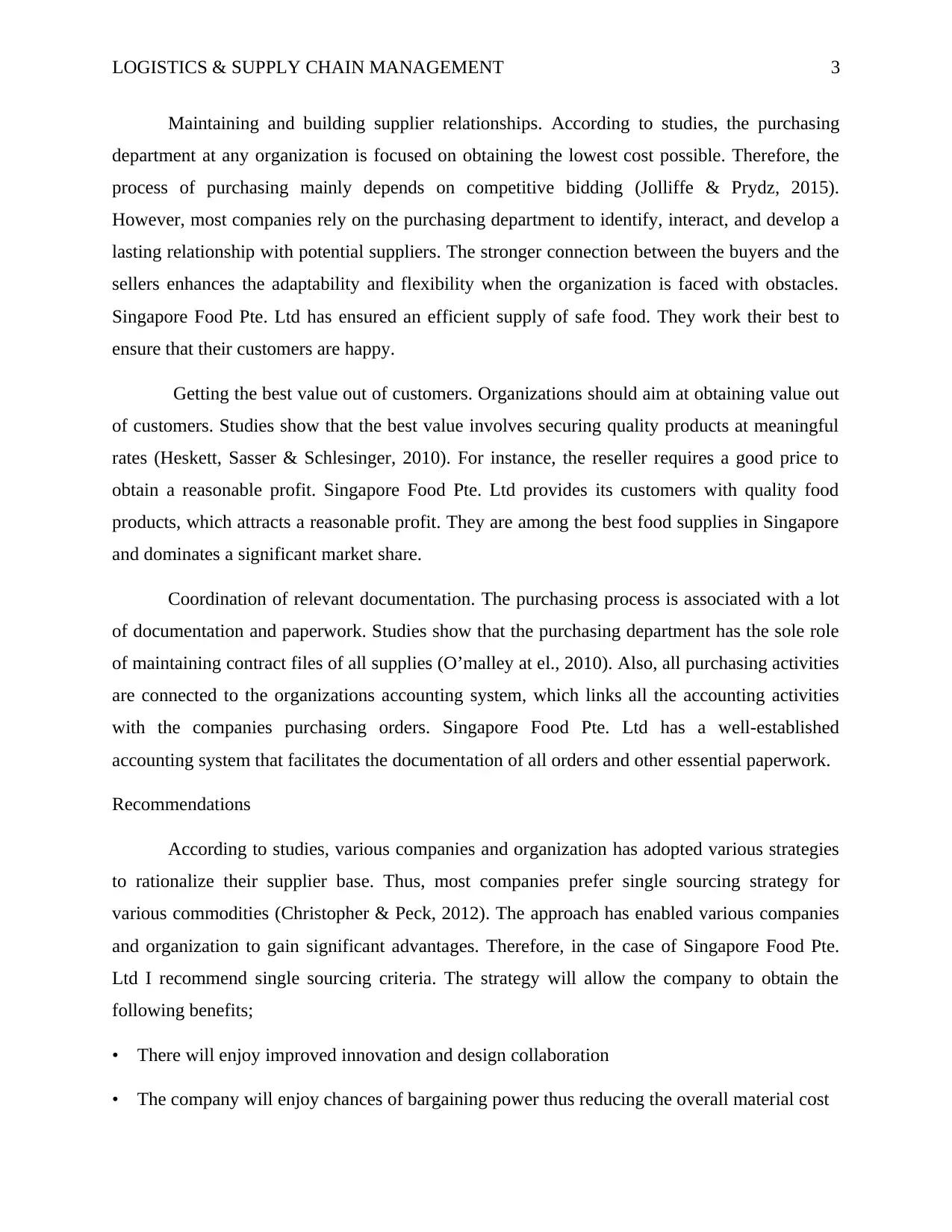
LOGISTICS & SUPPLY CHAIN MANAGEMENT 3
Maintaining and building supplier relationships. According to studies, the purchasing
department at any organization is focused on obtaining the lowest cost possible. Therefore, the
process of purchasing mainly depends on competitive bidding (Jolliffe & Prydz, 2015).
However, most companies rely on the purchasing department to identify, interact, and develop a
lasting relationship with potential suppliers. The stronger connection between the buyers and the
sellers enhances the adaptability and flexibility when the organization is faced with obstacles.
Singapore Food Pte. Ltd has ensured an efficient supply of safe food. They work their best to
ensure that their customers are happy.
Getting the best value out of customers. Organizations should aim at obtaining value out
of customers. Studies show that the best value involves securing quality products at meaningful
rates (Heskett, Sasser & Schlesinger, 2010). For instance, the reseller requires a good price to
obtain a reasonable profit. Singapore Food Pte. Ltd provides its customers with quality food
products, which attracts a reasonable profit. They are among the best food supplies in Singapore
and dominates a significant market share.
Coordination of relevant documentation. The purchasing process is associated with a lot
of documentation and paperwork. Studies show that the purchasing department has the sole role
of maintaining contract files of all supplies (O’malley at el., 2010). Also, all purchasing activities
are connected to the organizations accounting system, which links all the accounting activities
with the companies purchasing orders. Singapore Food Pte. Ltd has a well-established
accounting system that facilitates the documentation of all orders and other essential paperwork.
Recommendations
According to studies, various companies and organization has adopted various strategies
to rationalize their supplier base. Thus, most companies prefer single sourcing strategy for
various commodities (Christopher & Peck, 2012). The approach has enabled various companies
and organization to gain significant advantages. Therefore, in the case of Singapore Food Pte.
Ltd I recommend single sourcing criteria. The strategy will allow the company to obtain the
following benefits;
• There will enjoy improved innovation and design collaboration
• The company will enjoy chances of bargaining power thus reducing the overall material cost
Maintaining and building supplier relationships. According to studies, the purchasing
department at any organization is focused on obtaining the lowest cost possible. Therefore, the
process of purchasing mainly depends on competitive bidding (Jolliffe & Prydz, 2015).
However, most companies rely on the purchasing department to identify, interact, and develop a
lasting relationship with potential suppliers. The stronger connection between the buyers and the
sellers enhances the adaptability and flexibility when the organization is faced with obstacles.
Singapore Food Pte. Ltd has ensured an efficient supply of safe food. They work their best to
ensure that their customers are happy.
Getting the best value out of customers. Organizations should aim at obtaining value out
of customers. Studies show that the best value involves securing quality products at meaningful
rates (Heskett, Sasser & Schlesinger, 2010). For instance, the reseller requires a good price to
obtain a reasonable profit. Singapore Food Pte. Ltd provides its customers with quality food
products, which attracts a reasonable profit. They are among the best food supplies in Singapore
and dominates a significant market share.
Coordination of relevant documentation. The purchasing process is associated with a lot
of documentation and paperwork. Studies show that the purchasing department has the sole role
of maintaining contract files of all supplies (O’malley at el., 2010). Also, all purchasing activities
are connected to the organizations accounting system, which links all the accounting activities
with the companies purchasing orders. Singapore Food Pte. Ltd has a well-established
accounting system that facilitates the documentation of all orders and other essential paperwork.
Recommendations
According to studies, various companies and organization has adopted various strategies
to rationalize their supplier base. Thus, most companies prefer single sourcing strategy for
various commodities (Christopher & Peck, 2012). The approach has enabled various companies
and organization to gain significant advantages. Therefore, in the case of Singapore Food Pte.
Ltd I recommend single sourcing criteria. The strategy will allow the company to obtain the
following benefits;
• There will enjoy improved innovation and design collaboration
• The company will enjoy chances of bargaining power thus reducing the overall material cost
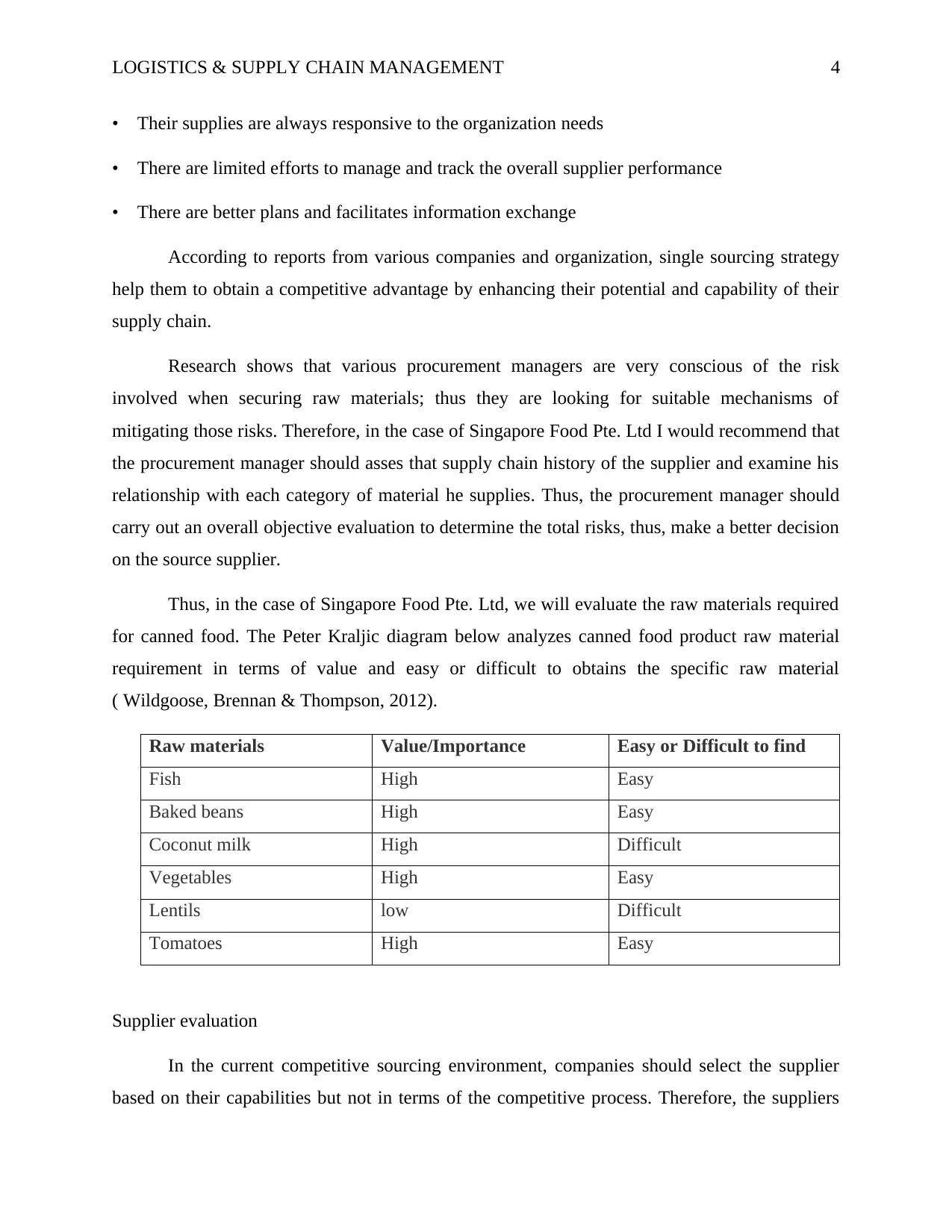
LOGISTICS & SUPPLY CHAIN MANAGEMENT 4
• Their supplies are always responsive to the organization needs
• There are limited efforts to manage and track the overall supplier performance
• There are better plans and facilitates information exchange
According to reports from various companies and organization, single sourcing strategy
help them to obtain a competitive advantage by enhancing their potential and capability of their
supply chain.
Research shows that various procurement managers are very conscious of the risk
involved when securing raw materials; thus they are looking for suitable mechanisms of
mitigating those risks. Therefore, in the case of Singapore Food Pte. Ltd I would recommend that
the procurement manager should asses that supply chain history of the supplier and examine his
relationship with each category of material he supplies. Thus, the procurement manager should
carry out an overall objective evaluation to determine the total risks, thus, make a better decision
on the source supplier.
Thus, in the case of Singapore Food Pte. Ltd, we will evaluate the raw materials required
for canned food. The Peter Kraljic diagram below analyzes canned food product raw material
requirement in terms of value and easy or difficult to obtains the specific raw material
( Wildgoose, Brennan & Thompson, 2012).
Raw materials Value/Importance Easy or Difficult to find
Fish High Easy
Baked beans High Easy
Coconut milk High Difficult
Vegetables High Easy
Lentils low Difficult
Tomatoes High Easy
Supplier evaluation
In the current competitive sourcing environment, companies should select the supplier
based on their capabilities but not in terms of the competitive process. Therefore, the suppliers
• Their supplies are always responsive to the organization needs
• There are limited efforts to manage and track the overall supplier performance
• There are better plans and facilitates information exchange
According to reports from various companies and organization, single sourcing strategy
help them to obtain a competitive advantage by enhancing their potential and capability of their
supply chain.
Research shows that various procurement managers are very conscious of the risk
involved when securing raw materials; thus they are looking for suitable mechanisms of
mitigating those risks. Therefore, in the case of Singapore Food Pte. Ltd I would recommend that
the procurement manager should asses that supply chain history of the supplier and examine his
relationship with each category of material he supplies. Thus, the procurement manager should
carry out an overall objective evaluation to determine the total risks, thus, make a better decision
on the source supplier.
Thus, in the case of Singapore Food Pte. Ltd, we will evaluate the raw materials required
for canned food. The Peter Kraljic diagram below analyzes canned food product raw material
requirement in terms of value and easy or difficult to obtains the specific raw material
( Wildgoose, Brennan & Thompson, 2012).
Raw materials Value/Importance Easy or Difficult to find
Fish High Easy
Baked beans High Easy
Coconut milk High Difficult
Vegetables High Easy
Lentils low Difficult
Tomatoes High Easy
Supplier evaluation
In the current competitive sourcing environment, companies should select the supplier
based on their capabilities but not in terms of the competitive process. Therefore, the suppliers
Secure Best Marks with AI Grader
Need help grading? Try our AI Grader for instant feedback on your assignments.
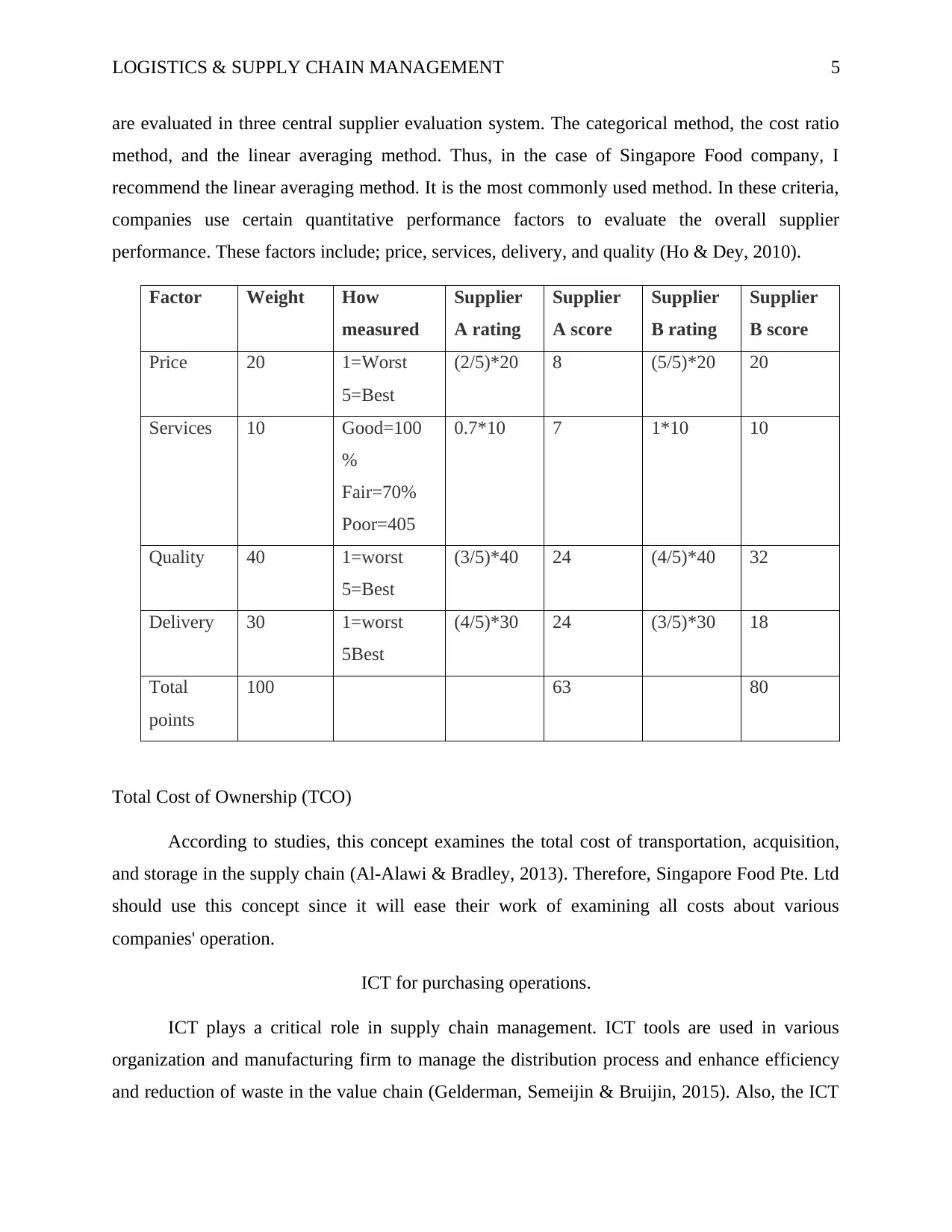
LOGISTICS & SUPPLY CHAIN MANAGEMENT 5
are evaluated in three central supplier evaluation system. The categorical method, the cost ratio
method, and the linear averaging method. Thus, in the case of Singapore Food company, I
recommend the linear averaging method. It is the most commonly used method. In these criteria,
companies use certain quantitative performance factors to evaluate the overall supplier
performance. These factors include; price, services, delivery, and quality (Ho & Dey, 2010).
Factor Weight How
measured
Supplier
A rating
Supplier
A score
Supplier
B rating
Supplier
B score
Price 20 1=Worst
5=Best
(2/5)*20 8 (5/5)*20 20
Services 10 Good=100
%
Fair=70%
Poor=405
0.7*10 7 1*10 10
Quality 40 1=worst
5=Best
(3/5)*40 24 (4/5)*40 32
Delivery 30 1=worst
5Best
(4/5)*30 24 (3/5)*30 18
Total
points
100 63 80
Total Cost of Ownership (TCO)
According to studies, this concept examines the total cost of transportation, acquisition,
and storage in the supply chain (Al-Alawi & Bradley, 2013). Therefore, Singapore Food Pte. Ltd
should use this concept since it will ease their work of examining all costs about various
companies' operation.
ICT for purchasing operations.
ICT plays a critical role in supply chain management. ICT tools are used in various
organization and manufacturing firm to manage the distribution process and enhance efficiency
and reduction of waste in the value chain (Gelderman, Semeijin & Bruijin, 2015). Also, the ICT
are evaluated in three central supplier evaluation system. The categorical method, the cost ratio
method, and the linear averaging method. Thus, in the case of Singapore Food company, I
recommend the linear averaging method. It is the most commonly used method. In these criteria,
companies use certain quantitative performance factors to evaluate the overall supplier
performance. These factors include; price, services, delivery, and quality (Ho & Dey, 2010).
Factor Weight How
measured
Supplier
A rating
Supplier
A score
Supplier
B rating
Supplier
B score
Price 20 1=Worst
5=Best
(2/5)*20 8 (5/5)*20 20
Services 10 Good=100
%
Fair=70%
Poor=405
0.7*10 7 1*10 10
Quality 40 1=worst
5=Best
(3/5)*40 24 (4/5)*40 32
Delivery 30 1=worst
5Best
(4/5)*30 24 (3/5)*30 18
Total
points
100 63 80
Total Cost of Ownership (TCO)
According to studies, this concept examines the total cost of transportation, acquisition,
and storage in the supply chain (Al-Alawi & Bradley, 2013). Therefore, Singapore Food Pte. Ltd
should use this concept since it will ease their work of examining all costs about various
companies' operation.
ICT for purchasing operations.
ICT plays a critical role in supply chain management. ICT tools are used in various
organization and manufacturing firm to manage the distribution process and enhance efficiency
and reduction of waste in the value chain (Gelderman, Semeijin & Bruijin, 2015). Also, the ICT
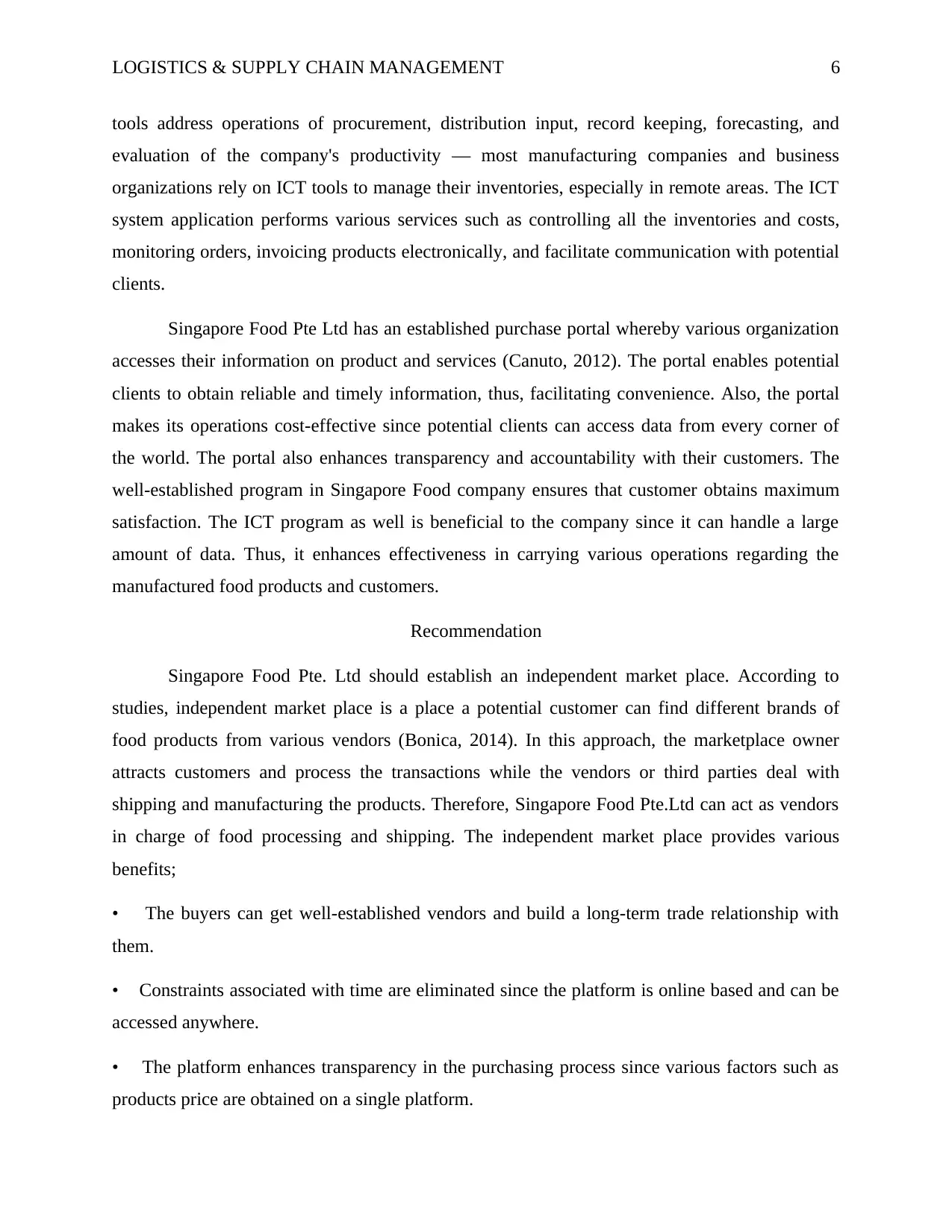
LOGISTICS & SUPPLY CHAIN MANAGEMENT 6
tools address operations of procurement, distribution input, record keeping, forecasting, and
evaluation of the company's productivity — most manufacturing companies and business
organizations rely on ICT tools to manage their inventories, especially in remote areas. The ICT
system application performs various services such as controlling all the inventories and costs,
monitoring orders, invoicing products electronically, and facilitate communication with potential
clients.
Singapore Food Pte Ltd has an established purchase portal whereby various organization
accesses their information on product and services (Canuto, 2012). The portal enables potential
clients to obtain reliable and timely information, thus, facilitating convenience. Also, the portal
makes its operations cost-effective since potential clients can access data from every corner of
the world. The portal also enhances transparency and accountability with their customers. The
well-established program in Singapore Food company ensures that customer obtains maximum
satisfaction. The ICT program as well is beneficial to the company since it can handle a large
amount of data. Thus, it enhances effectiveness in carrying various operations regarding the
manufactured food products and customers.
Recommendation
Singapore Food Pte. Ltd should establish an independent market place. According to
studies, independent market place is a place a potential customer can find different brands of
food products from various vendors (Bonica, 2014). In this approach, the marketplace owner
attracts customers and process the transactions while the vendors or third parties deal with
shipping and manufacturing the products. Therefore, Singapore Food Pte.Ltd can act as vendors
in charge of food processing and shipping. The independent market place provides various
benefits;
• The buyers can get well-established vendors and build a long-term trade relationship with
them.
• Constraints associated with time are eliminated since the platform is online based and can be
accessed anywhere.
• The platform enhances transparency in the purchasing process since various factors such as
products price are obtained on a single platform.
tools address operations of procurement, distribution input, record keeping, forecasting, and
evaluation of the company's productivity — most manufacturing companies and business
organizations rely on ICT tools to manage their inventories, especially in remote areas. The ICT
system application performs various services such as controlling all the inventories and costs,
monitoring orders, invoicing products electronically, and facilitate communication with potential
clients.
Singapore Food Pte Ltd has an established purchase portal whereby various organization
accesses their information on product and services (Canuto, 2012). The portal enables potential
clients to obtain reliable and timely information, thus, facilitating convenience. Also, the portal
makes its operations cost-effective since potential clients can access data from every corner of
the world. The portal also enhances transparency and accountability with their customers. The
well-established program in Singapore Food company ensures that customer obtains maximum
satisfaction. The ICT program as well is beneficial to the company since it can handle a large
amount of data. Thus, it enhances effectiveness in carrying various operations regarding the
manufactured food products and customers.
Recommendation
Singapore Food Pte. Ltd should establish an independent market place. According to
studies, independent market place is a place a potential customer can find different brands of
food products from various vendors (Bonica, 2014). In this approach, the marketplace owner
attracts customers and process the transactions while the vendors or third parties deal with
shipping and manufacturing the products. Therefore, Singapore Food Pte.Ltd can act as vendors
in charge of food processing and shipping. The independent market place provides various
benefits;
• The buyers can get well-established vendors and build a long-term trade relationship with
them.
• Constraints associated with time are eliminated since the platform is online based and can be
accessed anywhere.
• The platform enhances transparency in the purchasing process since various factors such as
products price are obtained on a single platform.
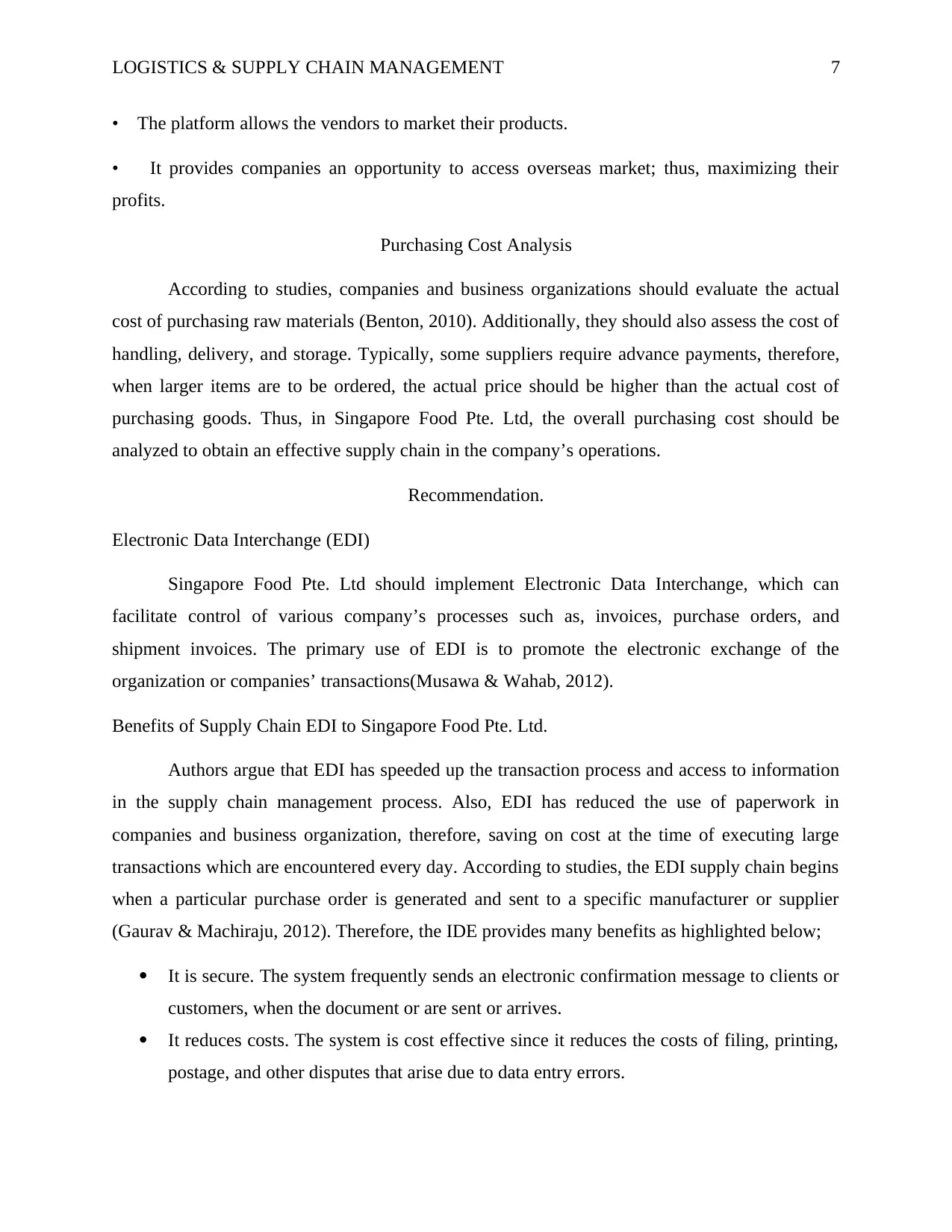
LOGISTICS & SUPPLY CHAIN MANAGEMENT 7
• The platform allows the vendors to market their products.
• It provides companies an opportunity to access overseas market; thus, maximizing their
profits.
Purchasing Cost Analysis
According to studies, companies and business organizations should evaluate the actual
cost of purchasing raw materials (Benton, 2010). Additionally, they should also assess the cost of
handling, delivery, and storage. Typically, some suppliers require advance payments, therefore,
when larger items are to be ordered, the actual price should be higher than the actual cost of
purchasing goods. Thus, in Singapore Food Pte. Ltd, the overall purchasing cost should be
analyzed to obtain an effective supply chain in the company’s operations.
Recommendation.
Electronic Data Interchange (EDI)
Singapore Food Pte. Ltd should implement Electronic Data Interchange, which can
facilitate control of various company’s processes such as, invoices, purchase orders, and
shipment invoices. The primary use of EDI is to promote the electronic exchange of the
organization or companies’ transactions(Musawa & Wahab, 2012).
Benefits of Supply Chain EDI to Singapore Food Pte. Ltd.
Authors argue that EDI has speeded up the transaction process and access to information
in the supply chain management process. Also, EDI has reduced the use of paperwork in
companies and business organization, therefore, saving on cost at the time of executing large
transactions which are encountered every day. According to studies, the EDI supply chain begins
when a particular purchase order is generated and sent to a specific manufacturer or supplier
(Gaurav & Machiraju, 2012). Therefore, the IDE provides many benefits as highlighted below;
It is secure. The system frequently sends an electronic confirmation message to clients or
customers, when the document or are sent or arrives.
It reduces costs. The system is cost effective since it reduces the costs of filing, printing,
postage, and other disputes that arise due to data entry errors.
• The platform allows the vendors to market their products.
• It provides companies an opportunity to access overseas market; thus, maximizing their
profits.
Purchasing Cost Analysis
According to studies, companies and business organizations should evaluate the actual
cost of purchasing raw materials (Benton, 2010). Additionally, they should also assess the cost of
handling, delivery, and storage. Typically, some suppliers require advance payments, therefore,
when larger items are to be ordered, the actual price should be higher than the actual cost of
purchasing goods. Thus, in Singapore Food Pte. Ltd, the overall purchasing cost should be
analyzed to obtain an effective supply chain in the company’s operations.
Recommendation.
Electronic Data Interchange (EDI)
Singapore Food Pte. Ltd should implement Electronic Data Interchange, which can
facilitate control of various company’s processes such as, invoices, purchase orders, and
shipment invoices. The primary use of EDI is to promote the electronic exchange of the
organization or companies’ transactions(Musawa & Wahab, 2012).
Benefits of Supply Chain EDI to Singapore Food Pte. Ltd.
Authors argue that EDI has speeded up the transaction process and access to information
in the supply chain management process. Also, EDI has reduced the use of paperwork in
companies and business organization, therefore, saving on cost at the time of executing large
transactions which are encountered every day. According to studies, the EDI supply chain begins
when a particular purchase order is generated and sent to a specific manufacturer or supplier
(Gaurav & Machiraju, 2012). Therefore, the IDE provides many benefits as highlighted below;
It is secure. The system frequently sends an electronic confirmation message to clients or
customers, when the document or are sent or arrives.
It reduces costs. The system is cost effective since it reduces the costs of filing, printing,
postage, and other disputes that arise due to data entry errors.
Paraphrase This Document
Need a fresh take? Get an instant paraphrase of this document with our AI Paraphraser
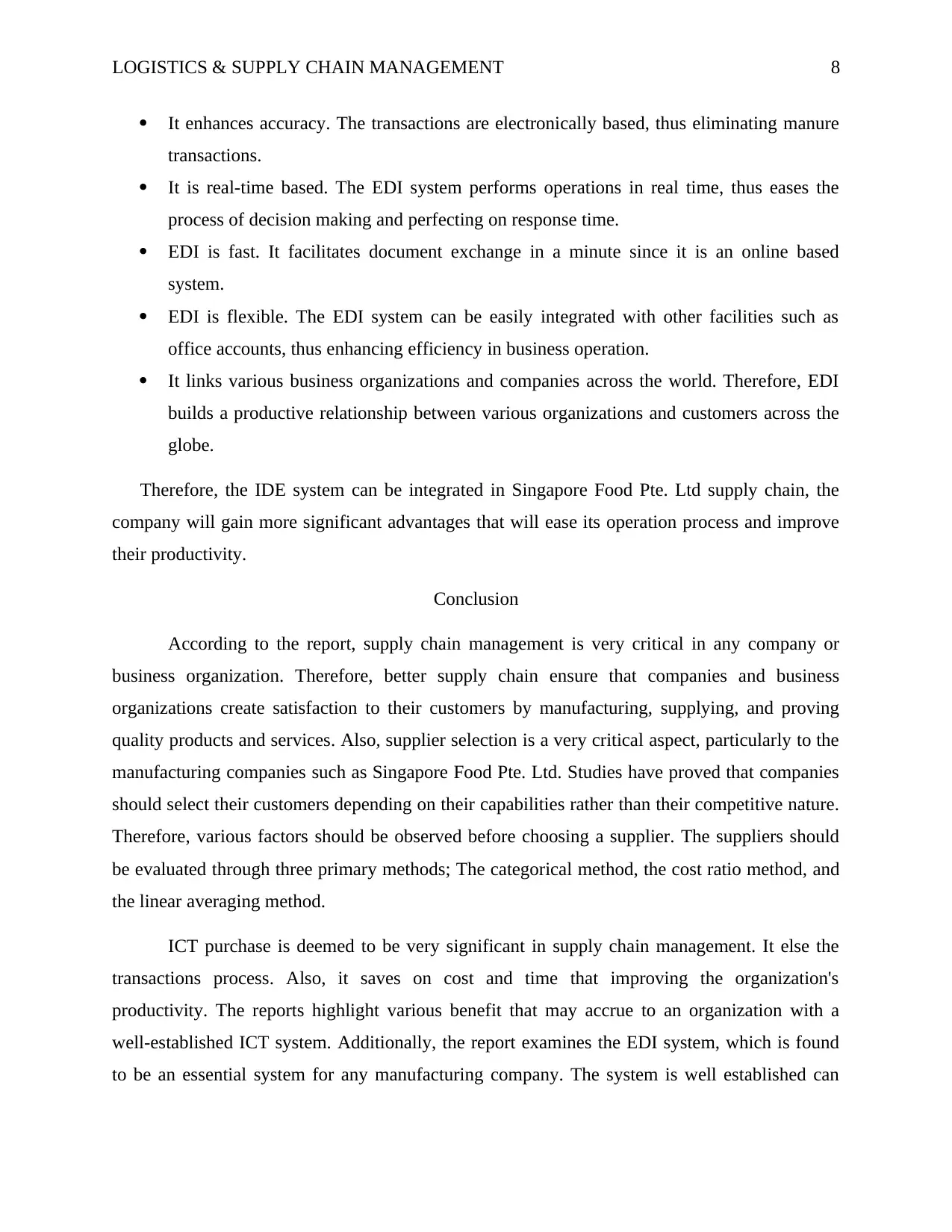
LOGISTICS & SUPPLY CHAIN MANAGEMENT 8
It enhances accuracy. The transactions are electronically based, thus eliminating manure
transactions.
It is real-time based. The EDI system performs operations in real time, thus eases the
process of decision making and perfecting on response time.
EDI is fast. It facilitates document exchange in a minute since it is an online based
system.
EDI is flexible. The EDI system can be easily integrated with other facilities such as
office accounts, thus enhancing efficiency in business operation.
It links various business organizations and companies across the world. Therefore, EDI
builds a productive relationship between various organizations and customers across the
globe.
Therefore, the IDE system can be integrated in Singapore Food Pte. Ltd supply chain, the
company will gain more significant advantages that will ease its operation process and improve
their productivity.
Conclusion
According to the report, supply chain management is very critical in any company or
business organization. Therefore, better supply chain ensure that companies and business
organizations create satisfaction to their customers by manufacturing, supplying, and proving
quality products and services. Also, supplier selection is a very critical aspect, particularly to the
manufacturing companies such as Singapore Food Pte. Ltd. Studies have proved that companies
should select their customers depending on their capabilities rather than their competitive nature.
Therefore, various factors should be observed before choosing a supplier. The suppliers should
be evaluated through three primary methods; The categorical method, the cost ratio method, and
the linear averaging method.
ICT purchase is deemed to be very significant in supply chain management. It else the
transactions process. Also, it saves on cost and time that improving the organization's
productivity. The reports highlight various benefit that may accrue to an organization with a
well-established ICT system. Additionally, the report examines the EDI system, which is found
to be an essential system for any manufacturing company. The system is well established can
It enhances accuracy. The transactions are electronically based, thus eliminating manure
transactions.
It is real-time based. The EDI system performs operations in real time, thus eases the
process of decision making and perfecting on response time.
EDI is fast. It facilitates document exchange in a minute since it is an online based
system.
EDI is flexible. The EDI system can be easily integrated with other facilities such as
office accounts, thus enhancing efficiency in business operation.
It links various business organizations and companies across the world. Therefore, EDI
builds a productive relationship between various organizations and customers across the
globe.
Therefore, the IDE system can be integrated in Singapore Food Pte. Ltd supply chain, the
company will gain more significant advantages that will ease its operation process and improve
their productivity.
Conclusion
According to the report, supply chain management is very critical in any company or
business organization. Therefore, better supply chain ensure that companies and business
organizations create satisfaction to their customers by manufacturing, supplying, and proving
quality products and services. Also, supplier selection is a very critical aspect, particularly to the
manufacturing companies such as Singapore Food Pte. Ltd. Studies have proved that companies
should select their customers depending on their capabilities rather than their competitive nature.
Therefore, various factors should be observed before choosing a supplier. The suppliers should
be evaluated through three primary methods; The categorical method, the cost ratio method, and
the linear averaging method.
ICT purchase is deemed to be very significant in supply chain management. It else the
transactions process. Also, it saves on cost and time that improving the organization's
productivity. The reports highlight various benefit that may accrue to an organization with a
well-established ICT system. Additionally, the report examines the EDI system, which is found
to be an essential system for any manufacturing company. The system is well established can
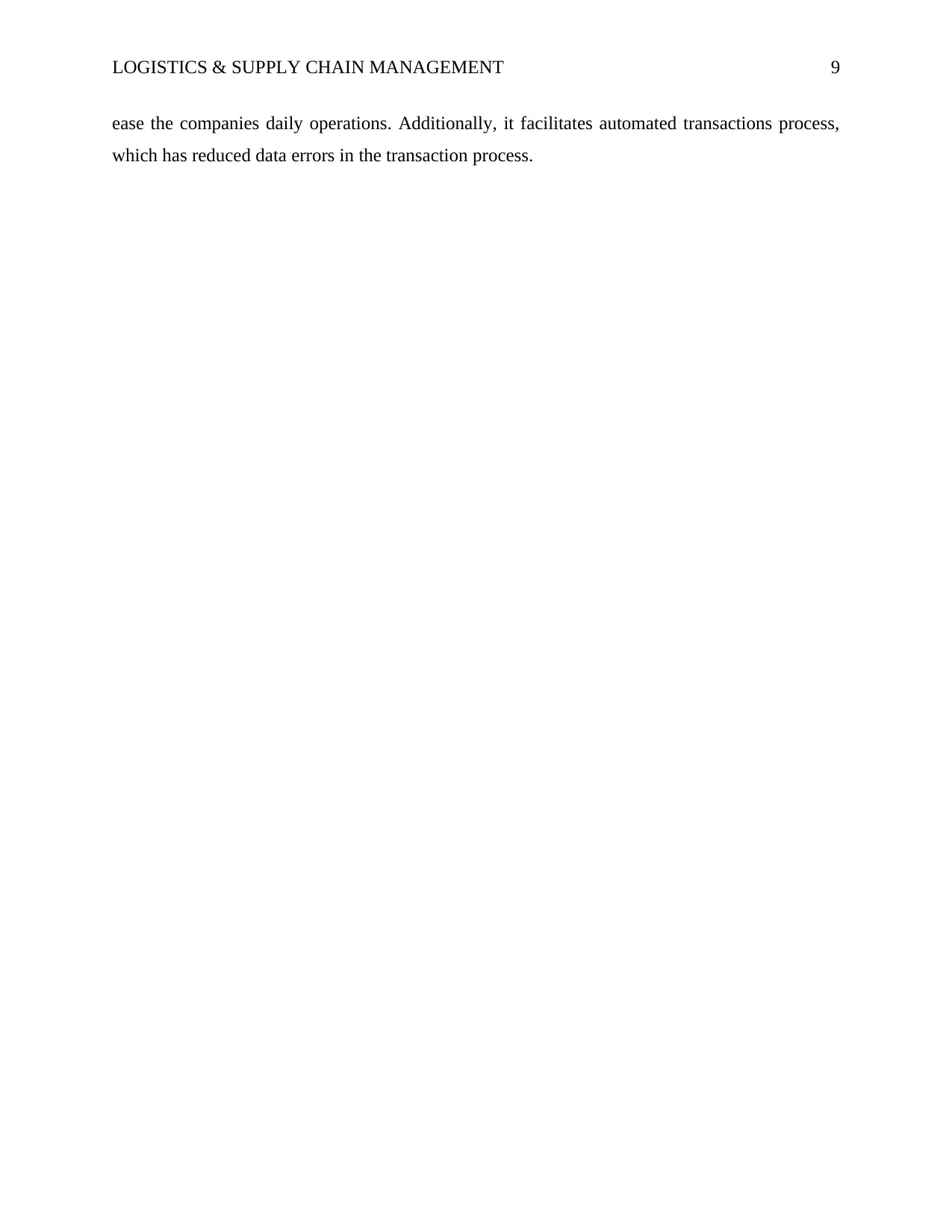
LOGISTICS & SUPPLY CHAIN MANAGEMENT 9
ease the companies daily operations. Additionally, it facilitates automated transactions process,
which has reduced data errors in the transaction process.
ease the companies daily operations. Additionally, it facilitates automated transactions process,
which has reduced data errors in the transaction process.
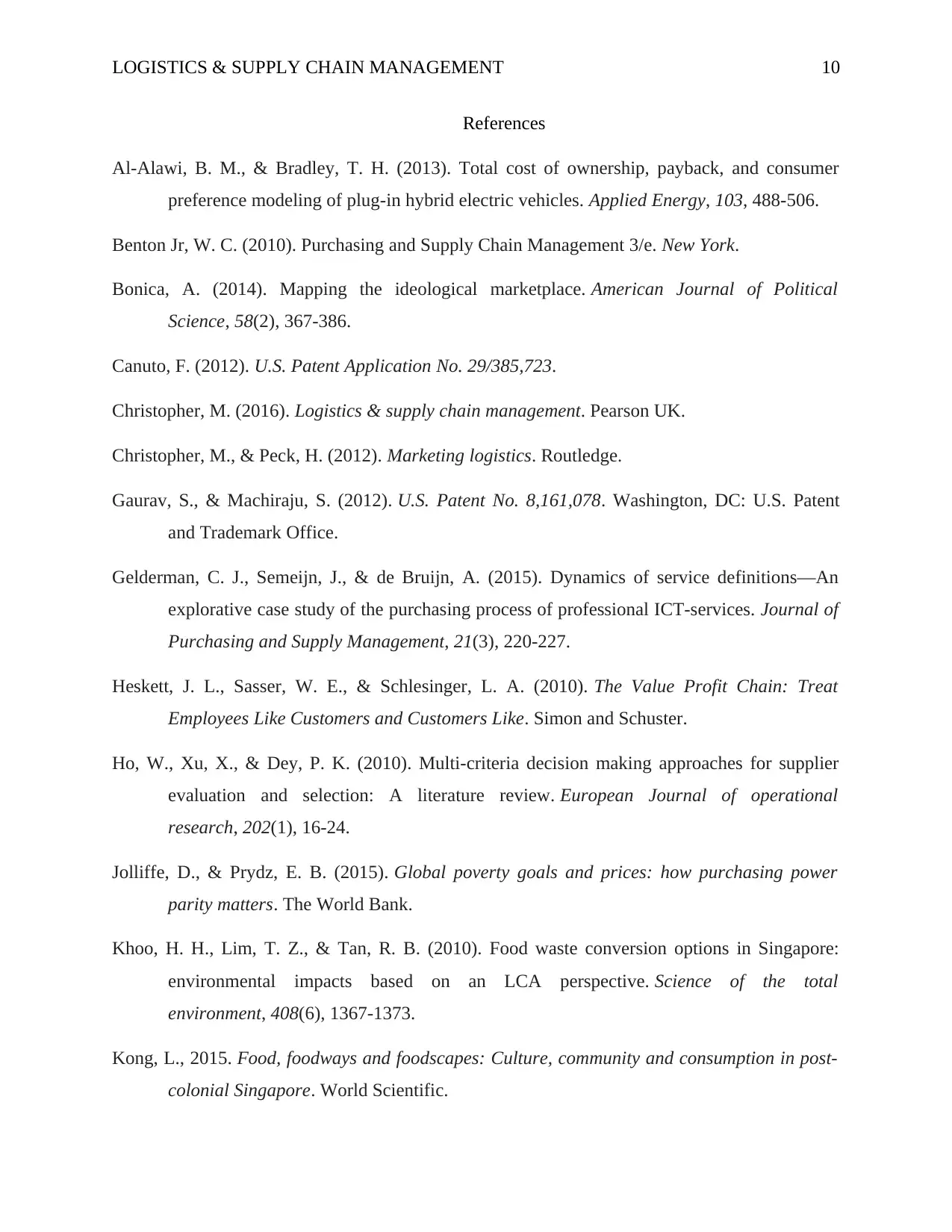
LOGISTICS & SUPPLY CHAIN MANAGEMENT 10
References
Al-Alawi, B. M., & Bradley, T. H. (2013). Total cost of ownership, payback, and consumer
preference modeling of plug-in hybrid electric vehicles. Applied Energy, 103, 488-506.
Benton Jr, W. C. (2010). Purchasing and Supply Chain Management 3/e. New York.
Bonica, A. (2014). Mapping the ideological marketplace. American Journal of Political
Science, 58(2), 367-386.
Canuto, F. (2012). U.S. Patent Application No. 29/385,723.
Christopher, M. (2016). Logistics & supply chain management. Pearson UK.
Christopher, M., & Peck, H. (2012). Marketing logistics. Routledge.
Gaurav, S., & Machiraju, S. (2012). U.S. Patent No. 8,161,078. Washington, DC: U.S. Patent
and Trademark Office.
Gelderman, C. J., Semeijn, J., & de Bruijn, A. (2015). Dynamics of service definitions—An
explorative case study of the purchasing process of professional ICT-services. Journal of
Purchasing and Supply Management, 21(3), 220-227.
Heskett, J. L., Sasser, W. E., & Schlesinger, L. A. (2010). The Value Profit Chain: Treat
Employees Like Customers and Customers Like. Simon and Schuster.
Ho, W., Xu, X., & Dey, P. K. (2010). Multi-criteria decision making approaches for supplier
evaluation and selection: A literature review. European Journal of operational
research, 202(1), 16-24.
Jolliffe, D., & Prydz, E. B. (2015). Global poverty goals and prices: how purchasing power
parity matters. The World Bank.
Khoo, H. H., Lim, T. Z., & Tan, R. B. (2010). Food waste conversion options in Singapore:
environmental impacts based on an LCA perspective. Science of the total
environment, 408(6), 1367-1373.
Kong, L., 2015. Food, foodways and foodscapes: Culture, community and consumption in post-
colonial Singapore. World Scientific.
References
Al-Alawi, B. M., & Bradley, T. H. (2013). Total cost of ownership, payback, and consumer
preference modeling of plug-in hybrid electric vehicles. Applied Energy, 103, 488-506.
Benton Jr, W. C. (2010). Purchasing and Supply Chain Management 3/e. New York.
Bonica, A. (2014). Mapping the ideological marketplace. American Journal of Political
Science, 58(2), 367-386.
Canuto, F. (2012). U.S. Patent Application No. 29/385,723.
Christopher, M. (2016). Logistics & supply chain management. Pearson UK.
Christopher, M., & Peck, H. (2012). Marketing logistics. Routledge.
Gaurav, S., & Machiraju, S. (2012). U.S. Patent No. 8,161,078. Washington, DC: U.S. Patent
and Trademark Office.
Gelderman, C. J., Semeijn, J., & de Bruijn, A. (2015). Dynamics of service definitions—An
explorative case study of the purchasing process of professional ICT-services. Journal of
Purchasing and Supply Management, 21(3), 220-227.
Heskett, J. L., Sasser, W. E., & Schlesinger, L. A. (2010). The Value Profit Chain: Treat
Employees Like Customers and Customers Like. Simon and Schuster.
Ho, W., Xu, X., & Dey, P. K. (2010). Multi-criteria decision making approaches for supplier
evaluation and selection: A literature review. European Journal of operational
research, 202(1), 16-24.
Jolliffe, D., & Prydz, E. B. (2015). Global poverty goals and prices: how purchasing power
parity matters. The World Bank.
Khoo, H. H., Lim, T. Z., & Tan, R. B. (2010). Food waste conversion options in Singapore:
environmental impacts based on an LCA perspective. Science of the total
environment, 408(6), 1367-1373.
Kong, L., 2015. Food, foodways and foodscapes: Culture, community and consumption in post-
colonial Singapore. World Scientific.
Secure Best Marks with AI Grader
Need help grading? Try our AI Grader for instant feedback on your assignments.
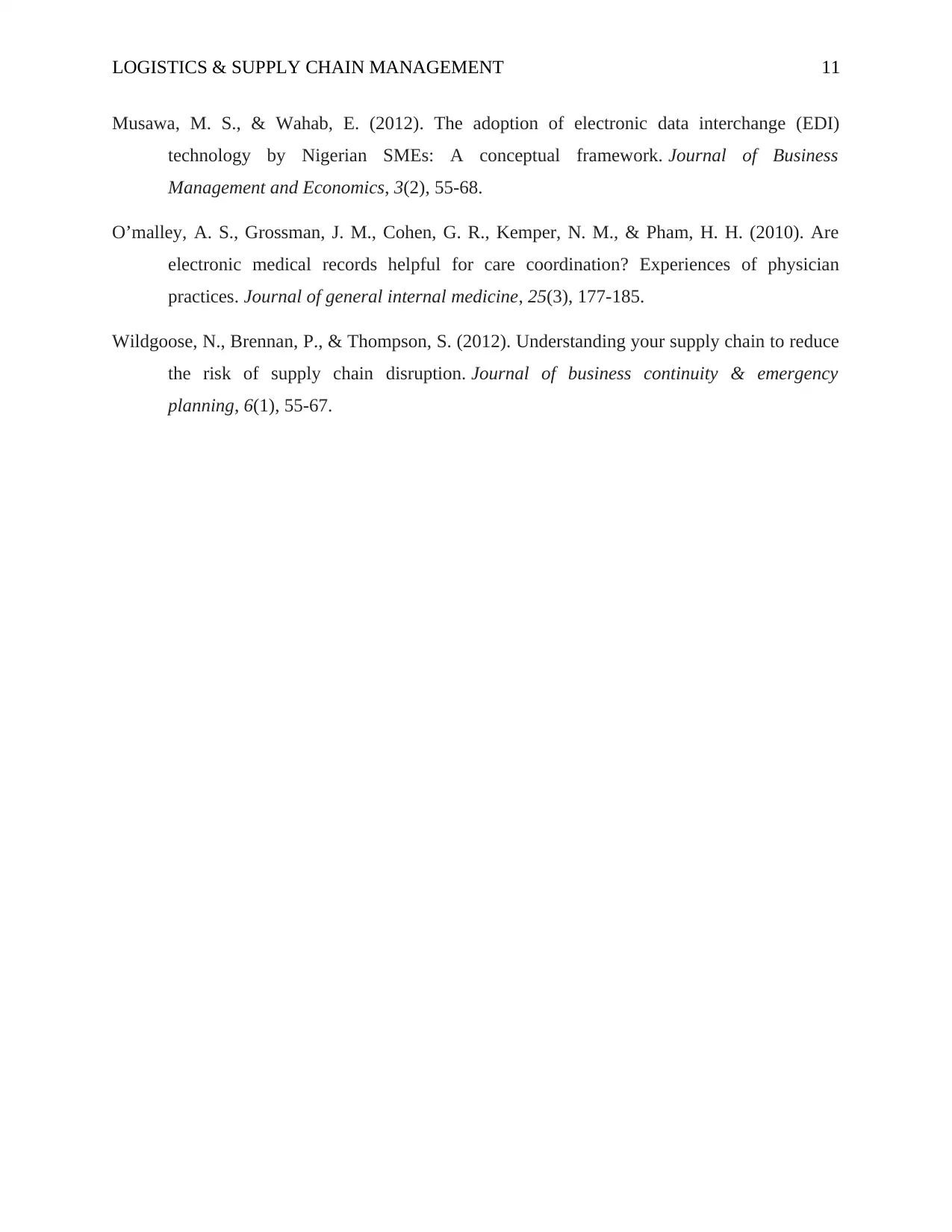
LOGISTICS & SUPPLY CHAIN MANAGEMENT 11
Musawa, M. S., & Wahab, E. (2012). The adoption of electronic data interchange (EDI)
technology by Nigerian SMEs: A conceptual framework. Journal of Business
Management and Economics, 3(2), 55-68.
O’malley, A. S., Grossman, J. M., Cohen, G. R., Kemper, N. M., & Pham, H. H. (2010). Are
electronic medical records helpful for care coordination? Experiences of physician
practices. Journal of general internal medicine, 25(3), 177-185.
Wildgoose, N., Brennan, P., & Thompson, S. (2012). Understanding your supply chain to reduce
the risk of supply chain disruption. Journal of business continuity & emergency
planning, 6(1), 55-67.
Musawa, M. S., & Wahab, E. (2012). The adoption of electronic data interchange (EDI)
technology by Nigerian SMEs: A conceptual framework. Journal of Business
Management and Economics, 3(2), 55-68.
O’malley, A. S., Grossman, J. M., Cohen, G. R., Kemper, N. M., & Pham, H. H. (2010). Are
electronic medical records helpful for care coordination? Experiences of physician
practices. Journal of general internal medicine, 25(3), 177-185.
Wildgoose, N., Brennan, P., & Thompson, S. (2012). Understanding your supply chain to reduce
the risk of supply chain disruption. Journal of business continuity & emergency
planning, 6(1), 55-67.
1 out of 11
Related Documents
Your All-in-One AI-Powered Toolkit for Academic Success.
+13062052269
info@desklib.com
Available 24*7 on WhatsApp / Email
![[object Object]](/_next/static/media/star-bottom.7253800d.svg)
Unlock your academic potential
© 2024 | Zucol Services PVT LTD | All rights reserved.





